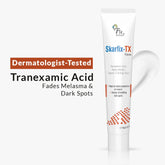Unravelling the Mystery of Melasma: Understanding and Treating Stubborn Pigmentation

The Intriguing World of Melasma
Welcome to the gripping world of Melasma, where science meets mystery and skin takes on a complex narrative. Picture a seemingly harmless patch of pigmentation on the face, resembling a shadowy veil but holding numerous stories - stories of hormonal changes, sun exposure, and genetic tendencies within it. Melasma, with its mysterious nature, has long fascinated dermatologists and patients, prompting us to explore its secrets further.
Consider living in a world where pigmentation defies conventional wisdom and skin tells its tale through the interactions between hormones and sunlight on the surface of our faces. This is the area of melasma, a condition that goes beyond mere cosmetic worries to delve into the intricacies of our physiology and the delicate balance of our skin's ecosystem.
Knowing about the intricacies of melasma proves to be more than just a pursuit of flawless skin; it's an exploration of the various factors underlying its occurrence. Melasma doesn't discriminate - it affects individuals across ages, genders, and backgrounds, shedding light on the universal nature of skin concerns. By unravelling the mechanisms behind melasma, we equip ourselves to understand its complexities adeptly, champion effective treatments, and foster a community founded on understanding and empathy.
Get ready to explore the world of melasma with us. Together, let's peel back the layers, confront the unknown, and emerge with a newfound understanding and appreciation for the intricacies of our skin. Welcome aboard!
What is Melasma? Let's start by understanding melasma. Melasma is not just typical skin pigmentation - it is a unique puzzle that shows up as patches of discolouration, often on the face. What makes it different? Melasma is not just about pigmentation; it is about how these patches form, their stubbornness, and their tendency to appear again despite treatment. Think of melasma as a painter's delicate yet persistent stroke on your skin, leaving behind traces that are hard to get rid of with usual remedies. Unlike freckles or age spots, which are usually consistent in colour and shape, melasma appears as irregular patches, varying in intensity and distribution. This unpredictability adds to its mystery and challenges traditional ideas about skin pigmentation.
Revealing the Triggers While the exact reasons are not fully understood, researchers have identified several key factors that contribute to its development. Hormonal changes, especially during pregnancy or when using oral contraceptives, lead to the overproduction of melanin - the pigment that gives skin its colour. But hormones are just one part of the puzzle. Sun exposure also plays a crucial role in triggering melasma, making existing pigmentation worse and stimulating the production of new melanin. Genetics also play a role, with some people more likely to develop melasma due to inherited factors.
Melasma can affect individuals of all ages, genders, and ethnicities. However, some groups are more prone to it, especially women of reproductive age and those with darker skin tones. Pregnancy-related hormonal changes can trigger melasma in women, earning it the nickname the mask of pregnancy. Men can also experience melasma, although it is less common. It can appear due to hormonal changes, sun exposure, or genetic factors. Regardless of gender or background, melasma can have a significant impact on self-esteem and quality of life, emphasising the need to understand and address this condition thoroughly. By gaining a deeper understanding of its complexities, we can better manage its challenges and develop more effective treatment strategies. Medical professionals often encourage us to use sunscreen as a part of our daily skincare routine, as a prevention against melasma.
The Science Behind Melasma
Understanding Hormonal Influences Let's explore how hormones impact melasma. Hormones are vital chemical messengers that regulate various bodily functions and play a significant role in the development and worsening of melasma. Estrogen and progesterone, in particular, are linked to triggering melasma, especially during hormonal fluctuations like pregnancy, oral contraceptive use, or hormone replacement therapy. Think of hormones as conductors in a symphony, directing the production of melanin, the pigment responsible for skin colour. When hormones are imbalanced, such as during pregnancy or hormonal therapy, they can prompt skin cells to produce excess melanin, leading to melasma patches.
Sun Exposure and Melasma Sun exposure plays a crucial role in melasma development. While sunlight is essential for vitamin D production and overall health, it can also trigger melasma, worsening existing pigmentation and stimulating new melanin production. Sunlight can be likened to a double-edged sword—providing warmth and light but also causing melasma patches on the skin. Ultraviolet (UV) radiation, especially UVB and UVA rays, penetrates the skin, activating melanocytes, the cells responsible for melanin production. In people predisposed to melasma, this process can become disrupted, leading to uneven pigment distribution and the formation of melasma patches, particularly in sun-exposed areas.
Genetics and Other Factors Apart from hormones and sun exposure, genetics and other factors also contribute to melasma development. Genetics act as a blueprint shaping how our skin responds to internal and external factors, potentially predisposing some individuals to melasma due to inherited traits. Certain genetic variations can influence the expression of genes involved in melanin production, making some individuals more prone to melasma. Additionally, factors like inflammation, thyroid issues, and medications can also impact melasma development, highlighting the complex nature of this condition.
In the intricate interplay of hormones, sunlight, genetics, and other factors lies the essence of melasma - a condition that requires a comprehensive understanding for effective management. By exploring the science of melasma, we can better grasp its complexities and enhance treatment and prevention strategies.
Signs and Symptoms
Recognising Melasma Let's take a closer look at how to recognise melasma amidst the myriad of skin concerns. Melasma often presents as irregular patches of hyperpigmentation on the face, typically appearing on areas exposed to sunlight, such as the cheeks, forehead, nose, and upper lip. These patches appear as delicate brushstrokes on your skin, distinct in their irregularity and varying in intensity. Unlike freckles or age spots, which tend to be uniform in colour and shape, melasma patches may exhibit a mottled or blotchy appearance, ranging from light brown to dark brown. Imagine looking in the mirror and noticing these patches, a subtle reminder of the complex interplay of factors underlying melasma.
Types of Melasma Melasma isn't a one-size-fits-all condition - it comes in different variations, each with its unique characteristics. There are three primary types of melasma: Epidermal, Dermal, and Mixed. EpidermalMelasma manifests as brown patches that primarily affect the superficial layers of the skin, while dermal melasma appears as bluish-grey patches that penetrate deeper into the skin. Mixed melasma, as the name suggests, combines elements of both epidermal and dermal melasma, resulting in patches that exhibit characteristics of both types. Imagine these variations as different chapters in the story of melasma, each revealing a different facet of its complexity and challenging our understanding of skin pigmentation.
When to See a Dermatologist While melasma is typically benign, there are instances where seeking professional guidance is warranted. If you notice sudden or significant changes in your skin pigmentation, or if your melasma patches are accompanied by other concerning symptoms such as itching, inflammation, or ulceration, it's essential to consult a dermatologist promptly. Also, if you're pregnant or planning to become pregnant and notice the onset of melasma, discussing your concerns with a healthcare provider can provide valuable insights and guidance. Remember, early intervention is key to effective management, so don't hesitate to reach out for help if you have any doubts or concerns about your skin health.
Recognising the signs and symptoms is the first step towards effective management of melasma and empowerment. By understanding the common indicators, variations, and red flags associated with melasma, we can navigate its complexities with confidence and seek the support needed to maintain healthy, radiant skin.
Treatment Options
Topical Treatments Topical treatments like creams and serums are key in addressing melasma. These products contain active ingredients such as hydroquinone, retinoids, corticosteroids, and kojic acid. They work by reducing melanin production, promoting cell turnover, and decreasing inflammation. Fixderma offers a variety of sunscreens for different skin types and sun exposure levels. Their products protect against UVA and UVB rays, helping to prevent sun-induced pigmentation and protect your skin.
Consider these topical treatments as gentle encouragements for your skin, helping it find balance. By using them regularly as advised by your dermatologist, you can gradually fade melasma patches and achieve a more even skin tone. It's important to be patient and consistent, as it may take weeks to months to see visible results.
Procedures and Therapies For those looking for more intensive treatments, procedures like laser therapy and chemical peels can be effective for managing melasma. Laser treatments target melanin deep in the skin, while chemical peels use exfoliating agents to reveal fresher skin.
Lifestyle Changes In addition to treatments, lifestyle changes are important for managing melasma. Sun protection is crucial - wearing sunscreen daily, seeking shade, and using protective clothing can help prevent pigmentation. Having a skincare routine tailored to your needs, avoiding harsh products, and maintaining a healthy lifestyle can also support melasma management. Consistency is key—by following these habits daily, you can work towards clearer, healthier skin.
There are various options for managing melasma, including treatments, procedures, and lifestyle changes. By working with a dermatologist and caring for your skin, you can achieve clearer, healthier skin and boost your confidence.
Myth vs. Fact: Dispelling Misconceptions About Melasma
Debunking Common Myths Surrounding Melasma In the world of skincare, myths are common, and melasma is no different. Let's clear up some of the most common myths about this skin condition.
Myth: Melasma only affects women.
Fact: Melasma is more common in women, but men can also get it. Hormonal changes, sun exposure, and genetics can all play a role in melasma for anyone.
Myth: Melasma is caused by poor hygiene.
Fact: Melasma is not caused by poor hygiene—it's a combination of hormones, genetics, and the environment. While a good skincare routine is important, cleanliness is not the sole cause of melasma.
Myth: Sunscreen isn't necessary for melasma prevention.
Fact: Sunscreen is crucial for preventing melasma and protecting against sun-induced pigmentation. UV exposure can worsen melasma and lead to new patches, so daily sun protection is essential for managing melasma.
Clarifying Misunderstandings About Treatment Effectiveness Understanding melasma treatments can be overwhelming, especially with conflicting information online. Let's clear up some misunderstandings about treatment effectiveness.
Misunderstanding: Topical treatments can cure melasma completely.
Clarification: Topical treatments can fade melasma and improve skin tone, but they usually provide temporary results and need ongoing maintenance. Melasma is a chronic condition, so long-term management is needed to prevent it from coming back.
Misunderstanding: Laser treatments are a quick fix for melasma.
Clarification: Laser treatments can help with melasma, but they often require multiple sessions and may not be suitable for all skin types. Results can vary, and follow-up treatments may be necessary to maintain improvement.
With accurate information, people can make informed choices about their skincare and melasma treatment. Let's give individuals the knowledge they need to confidently navigate melasma. By debunking myths, clearing up misunderstandings, and providing accurate information, we can help people take charge of their skin health and find the right treatment options. Remember, knowledge is power and understanding the facts about melasma can help us manage it better and achieve clearer, healthier skin.
Coping Strategies and Support
Melasma is a condition that affects the skin and can lead to various physical symptoms. It is not just about treating the symptoms but also about nurturing emotional well-being. To manage melasma emotionally, one should practice self-compassion, focus on what they can control, surround themselves with positivity, and build a support network of understanding individuals who share similar experiences.
Connecting with others who understand melasma can provide comfort and reassurance during difficult times. Sharing stories, tips, and encouragement can foster a sense of community and camaraderie. Emotional support from friends, family members, or online support groups can make a world of difference. Empowerment through solidarity can help challenge stigma and promote inclusivity in the journey towards self-acceptance and empowerment.
Sometimes, managing the emotional impact of melasma may require professional help. Counselling and therapy can provide a safe space for exploring feelings, developing coping strategies, and working through underlying issues contributing to distress. Therapists can help process complex emotions, teach practical coping skills, and offer holistic support for emotional well-being.
Holistic support addresses not only the symptoms but also the underlying factors contributing to distress, such as body image issues, self-esteem concerns, or relationship difficulties. Reaching out to a qualified therapist or counsellor is a sign of strength, not weakness. If you are struggling to cope with the emotional impact of melasma, don't hesitate to reach out to a qualified therapist or counsellor who can support you on your journey towards healing and self-acceptance.
Prevention Tips
Shielding Your Skin From Harmful Sun Rays To prevent melasma, it's crucial to protect your skin from the sun. Sunlight can trigger melasma and worsen existing pigmentation, so daily sun protection is essential for your skincare routine. Follow these sun protection strategies to keep your skin safe:
- Use broad-spectrum sunscreen: Choose a sunscreen that guards against both UVA and UVB rays with an SPF of 30 or higher. Apply it generously to all exposed skin, including your face, neck, and hands, and reapply every two hours, or more often if swimming or sweating.
- Stay in the shade: Limit your time in direct sunlight, especially between 10 a.m. and 4 p.m. Seek shade under trees, umbrellas, or protective clothing when outdoors to reduce sun exposure.
- Wear protective clothing: Cover up with lightweight, long-sleeved clothes, wide-brimmed hats, and UV-protective sunglasses to shield your skin and eyes from the sun's harmful rays.
Hormonal Management: Safely Navigating Hormonal Fluctuations
Hormonal changes significantly impact melasma, so managing hormones is crucial for prevention. Whether you're pregnant, using oral contraceptives, or undergoing hormone replacement therapy, here are some tips for navigating hormonal changes safely:
- Consult your healthcare provider: If you're planning a pregnancy or experiencing hormonal shifts, seek guidance from your healthcare provider. They can explain how these changes may affect your skin and offer advice on managing melasma safely.
- Explore alternative contraceptives: If you're prone to melasma or have had it during previous pregnancies, discuss alternative contraceptive options with your healthcare provider that may pose a lower risk of triggering melasma.
- Hormone replacement therapy: If you're on hormone replacement therapy, collaborate closely with your healthcare provider to monitor your skin and adjust your treatment plan as needed. They can help you find the right hormone balance to minimize melasma flare-ups.
Maintaining a Healthy Lifestyle: Enhancing Overall Skin Health
Apart from sun protection and hormonal management, a healthy lifestyle can boost overall skin health and lower the risk of melasma. Follow these lifestyle tips for radiant skin:
- Stay hydrated: Drink enough water to keep your skin hydrated and supple. Aim for at least eight glasses a day and include hydrating foods like fruits and vegetables in your diet.
- Eat a balanced diet: Fuel your body with a diet rich in vitamins, minerals, and antioxidants that support skin health. Include plenty of fruits, veggies, lean proteins, and whole grains in your meals to nourish your skin from within.
- Manage stress: Chronic stress can worsen skin conditions like melasma, so prioritise stress management techniques such as meditation, yoga, deep breathing, or enjoyable hobbies.
By following these sun protection strategies, managing hormonal changes safely, and maintaining a healthy lifestyle, you can proactively prevent melasma and enhance overall skin health. Remember, prevention is crucial, so incorporate these tips into your daily routine to keep your skin radiant and protected in the long run.
Key Takeaways on Melasma Melasma, a common skin condition causes dark patches on the face. It can be triggered by hormonal changes, sun exposure, genetics, and other factors. Understanding the causes is important for managing and preventing it. Treatment options include creams, laser therapy, chemical peels, and lifestyle changes like protecting your skin from the sun and managing hormones. Coping strategies and support networks can help you deal with the emotional impact of living with melasma and feel more confident in your skin. If you have melasma, remember that you are not alone and your worth goes beyond your appearance. Embrace your unique qualities, strengths, and achievements, and don't let melasma affect your self-esteem. Reach out to friends, family, support groups, or healthcare providers for understanding, encouragement, and advice.
Acknowledge your strength in facing challenges and keep advocating for your skin health. With patience, self-care, and support, you can navigate the highs and lows of living with melasma and come out stronger and more confident. Keep shining bright, knowing that you deserve love, acceptance, and self-compassion.








